Table of Contents[Hide][Show]
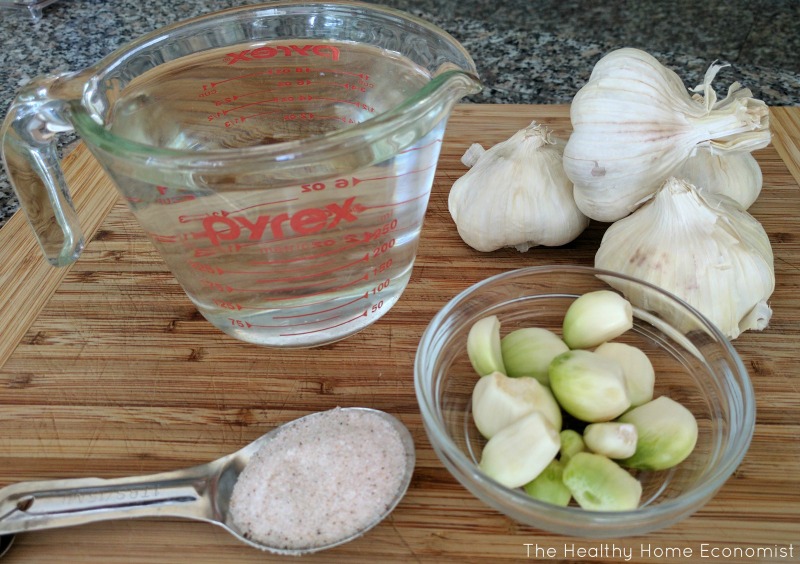
If you peruse the most popular pickled garlic recipes on the internet, nearly every single one contains vinegar and/or sugar. Even more problematic, the instructions frequently suggest using white vinegar and refined white sugar.
Both of these ingredients are almost always GMO frankenfoods at least in North America! The vinegar is derived from glyphosate laced GMO corn and usually the white sugar from Roundup Ready GMO sugarbeets. If you thought the white or brown sugar at the store was pure cane sugar, guess again. Unless the packaging specifically says “cane sugar”, it’s all or partially derived from gut destroying GMO beets.
Even worse (if that’s possible), the recipes suggest cooking the garlic!
Unfortunately, this isn’t the optimal way to go about it – certainly not if you wish to enhance the natural anti-viral, anti-fungal, and antibiotic power of garlic.
Raw garlic is a highly potent weapon for staying healthy. It is effective at fighting, not just pathogenic bacteria. It fights all harmful microbes including viruses and fungi. For this reason alone, it far outperforms synthetic antibiotics for non-life-threatening infections and illnesses when used properly. What’s more, garlic doesn’t harm your beneficial intestinal microbes and unbalance the gut for months or even years afterward as meds do.
Why in the world would you want to destroy all those unmatched benefits by cooking the cloves and then pickling in vinegar and sugar?
The key is to ferment the garlic.
~Fermented vegetables are always pickled, but not all pickled vegetables are fermented~
This article on pickled vs fermented foods contains more information so that you don’t ever get fooled into thinking a pickled food at the store has probiotic value. Check the ingredients. If there’s vinegar and/or sugar listed, don’t buy it.
Benefits of Pickled Garlic
Perhaps the greatest benefits of pickling garlic instead of eating it without fermenting are these:
- The inherent hotness of eating a raw clove is greatly reduced and/or virtually eliminated.
- The icky potential for reeking of garlic on your breath and in your sweat goes bye-bye.
Hence, fermenting garlic eliminates the negative aspects of eating raw garlic without reducing or eliminating any of the natural benefits. In addition, the probiotic and enzymatic value of garlic is enhanced by fermentation.
There just isn’t any reason whatsoever to pickle cooked garlic in vinegar. Unless of course you are a food manufacturer and mass production and supermarket shelf life are of primary concern.
Using Fermented Garlic Therapeutically
I recently gave a talk at my daughter’s school on the immune system. The teacher hosting the class told me that he knows a farmer who eats a raw clove of garlic every day to help ward off illness.
Dr. Natasha Campbell-McBride MD, author of the bestselling book about the GAPS Diet, would concur. In fact, she recommends eating an entire head of garlic per day (one clove every few hours during waking hours) until the illness or infection subsides.
The great thing about having a jar of fermented garlic on hand is that you can easily grab a clove or two whenever you need it. This is reminiscent of having a jar of the Master Tonic in the pantry during cold/flu season.
I like to suck on a clove as a natural remedy for sore throat. While sucking on a raw clove (let alone chewing it) is too hot for many people, sucking on a pickled clove is easy to do. In fact, the flavor is similar to roasted garlic and quite tasty. Thus, fermented garlic cloves are a great option for children over age 3.
As mentioned before, those who are sensitive to raw garlic will likely find pickled garlic to be no problem. The fermentation process conveniently eliminates some of the stinky aspects of the body and breath afterward.
Pickling garlic that is properly fermented is also a frugal alternative to using garlic or allicin supplements. On the positive side, buffered garlic in pill form is very convenient for traveling, so don’t completely discount this as an option on occasion.
Pickled Garlic Recipe
Cori H. of Billings, Montana suggested the wonderfully easy recipe for pickled garlic below. Cori is also the local Weston Price (WAPF) Chapter Leader if you happen to live in that area and would like more local food ideas. You can check out her blog by clicking here.
Green Garlic?
Please note that sometimes pickling garlic will turn slightly greenish or bluish. It is perfectly safe to eat. This is in contrast to white potatoes that are green under the skin, which should be tossed!
Garlic naturally contains beneficial sulfur compounds that can react with the copper in water to form copper sulfate. This is a blue or blue-green compound. The amount of copper needed for this reaction is very small and is frequently found in normal water supplies even when the water is filtered. If you have reverse-osmosis water, you probably won’t experience this while pickling garlic as RO water removes most of the minerals.
The bottom line is as long as the cloves are nestled safely within the brine water, a slight color change isn’t a problem. One of the wonders of fermentation is that each batch can turn out a bit differently!
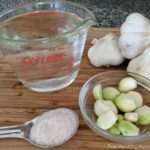
Pickled Garlic
Easy recipe for pickled garlic that will boost the flavor of dishes and can also be used medicinally as a natural antibiotic and anti-viral.
Ingredients
- 5-6 heads of garlic preferably organic
- 1 pint filtered water
- 1 Tbl sea salt
Instructions
-
Separate all the cloves from each head of garlic.
-
Carefully remove the papery skin from each clove.
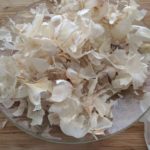
-
Place all the cloves in a mason jar and fill with filtered water mixed with sea salt.
-
Place a fermentation weight on top. This will keep the cloves at the bottom of the jar when the water is added. This is a simpler and more frugal option than expensive Pickl-It jars and anaerobic lids.
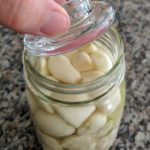
-
Make sure at least 1 inch is left for air at the top of the jar.
-
Close the lid tightly and place in a cool pantry or cabinet for one month. Best to label the lid so you remember when the fermentation began.
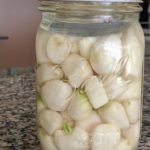
-
After one month, transfer to the refrigerator. Consume the pickled cloves as needed to flavor dishes and as one of the best natural antibiotics.
Recipe Notes
Do not use large elephant garlic, as it does not have the same therapeutic value.
You may wish to check on the pickling garlic every week or so during the month long fermentation. If the water level has decreased, add more brinewater as needed (1 Tbl sea salt per pint of filtered water).
**Open the jar over the sink as the pressure can build up substantially from the fermentation.
If you get sick during the time the garlic is pickling, feel free to dive into those cloves early. They will probably still be a little hot, but they will be highly therapeutic nonetheless.
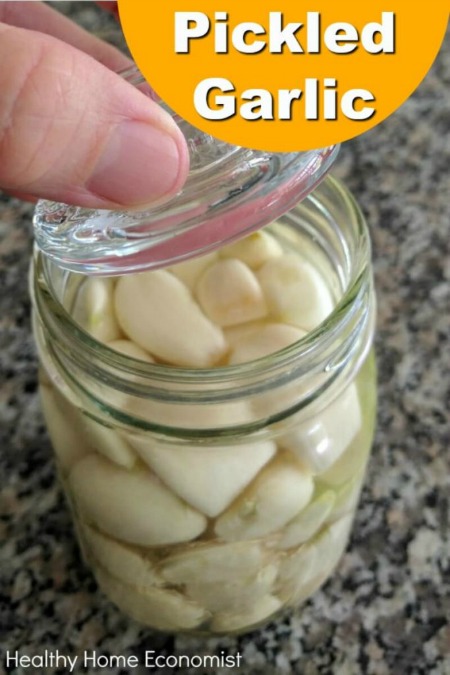








Can I pour off excess salted whey from my fermented salsa instead of using water?
Would adding some type of jalapeño or spice to the process take away at all from this?
Thanks for your quick reply Sarah. I figured the green was from the water but wasn’t sure about how murky the water was. I’ve never had a lacto-ferment get like that before. I think I will try again with organic garlic and RO water. Thanks again!
I tried this and after 4 weeks my garlic is looking bruised and the brine has turned quite greenish and murky. There were quite a few fermentation bubbles when I initially opened the jar. It looks rather funky and smells strongly of garlic (no surprise!). Any thoughts? Should I dump it and try again? The garlic wasn’t organic….
The green is from the copper in your water. I can’t speak to the nonorganic garlic though.
What about lacto – fermenting with garlic? Is that as beneficial and does it also help with the taste and spiciness issues?
This recipe is actually lacto-fermented garlic! And yes, it does help with the spiciness, although some folks might still find it too strong. I personally very much enjoy it compared with raw garlic.
I fermented my garlic for a month, but the garlic still tastes very, very strong and spicy. I don’t like the flavor at all. I think I prefer eating it raw! I was hoping it would taste mild enough to give to my kids when needed, but there is no way they would eat it like this. Too bad. 🙁
My garlic has been fermenting close to a month. It still smells fairly strong, although much less than in the beginning. I want to get it to the point where it’s sweeter. Can I ferment it for longer than a month?
That is up to you. I have not fermented it for longer than a month so you would be on your own there.
Yes. I’ve wondered about adding whey to the recipe, too. The Nourishing Traditions cookbook gives the option of adding whey instead if sea salt. Would the whey add a sweetness to the garlic? Could you add both whey and sea salt to the recipe? Sweet and salty tastes awesome. Or would that be overdoing the fermentation process? I love eating the black, fermented garlic that I’ve ordered on Amazon; the Asians have a lengthy process for their black garlic and I know I wouldn’t be duplicating their product with this pickling recipe but I’ve also wanted try pickling my own garlic for the health reasons. The black garlic is delish–sweet actually–but even though the maker touts it’s many health benefits, but I’ve wondered if they had to apply ‘light pasteurization’ to the product during it manufacture because it’s being sold for public consumption. Lately I’ve been disappointed to discover that the Bubbies brand saurkraut, also advertised as ‘raw and abundant with probiotics” has to use pasteurization for public health reasons. And that’s another reason I want to start fermenting my own saurkraut and other vegetables — you can’t trust advertising and can only know what’s in a product unless you make it yourself! Any comments on this post would’ve be appreciated. Thanks!
Yes, I noticed that Nourishing Traditions cookbook had a recipe for many of their pickled vegetables, garlic included, that you could optionally add whey, instead of sea salt. Hope the garlic does develop a sweetness because I love black fermented garlic from Amazon. I know the asians use a different, lengthy process; I just wasn’t really sure if theirs had been ‘lightly’ pasteurized since it was manufactured for public consumption. If it was I’d assume it wouldn’t have all the antibiotic properties in it; that’s why I want to try pickling my own garlic to use for health reasons.
No it doesn’t. I’ve had it in the garage for over two weeks. The odor is still extremely strong. I’m hoping it starts to dissipate soon or I will have to throw it away
I place my jar either in a gallon zip-lock or a cooler to cut down on the smell. The cooler works best and also keeps the temp from fluctuating a lot.